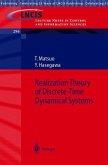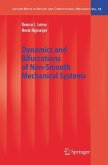This book presents a computational approach to the analysis of nonlinear and uncertain systems. The main focus is systems with piecewise linear dynamics. The class of piecewise linear systems examined has nonlinear, possibly discontinuous dynamics, and allows switching rules that incorporate memory and logic. These systems may exhibit astonishingly complex behaviors. Some aspects of the successful theory of linear systems and quadratic criteria are extended here to piecewise linear systems and piecewise quadratic criteria. The book also describes numerical procedures for assessing stability, computing induced gains, and solving optimal control problems for piecewise linear systems. These developments enable researchers to analyze a large and practically important class of control systems that are not easily dealt with when using other techniques.
2. Piecewise Linear Modeling . . . . . . . . . . . . . . . . . . . . . 9 2. 1 Model Representation . . . . . . . . . . . . . . . . . . . . . 9 2. 2 Solution Concepts . . . . . . . . . . . . . . . . . . . . . . . 2. 3 Uncertainty Models . . . . . . . . . . . . . . . . . . . . . . 2. 4 Modularity and Interconnections . . . . . . . . . . . . . . 26 2. 5 Piecewise Linear Function Representations . . . . . . . . . 28 2. 6 Comments and References . . . . . . . . . . . . . . . . . . 30 3. Structural Analysis . . . . . . . . . . . . . . . . . . . . . . . . . . 32 3. 1 Equilibrium Points and the Steady State Characteristic . . 32 3. 2 Constraint Verification and Invariance . . . . . . . . . . . 35 3. 3 Detecting Attractive Sliding Modes on Cell Boundaries 37 3. 4 Comments and References . . . . . . . . . . . . . . . . . . 39 4. Lyapunov Stability . . . . . . . . . . . . . . . . . . . . . . . . . . 41 4. 1 Exponential Stability . . . . . . . . . . . . . . . . . . . . . . 41 4. 2 Quadratic Stability . . . . . . . . . . . . . . . . . . . . . . . 42 4. 3 Conservatism of Quadratic Stability . . . . . . . . . . . . . 46 4. 4 From Quadratic to Piecewise Quadratic . . . . . . . . . . . 48 4. 5 Interlude: Describing Partition Properties . . . . . . . . . 51 4. 6 Piecewise Quadratic Lyapunov Functions . . . . . . . . . 55 4. 7 Analysis of Piecewise Linear Differential Inclusions . . . . 61 4. 8 Analysis of Systems with Attractive Sliding Modes . . . . 63 4. 9 Improving Computational Efficiency . . . . . . . . . . . . 66 4. 10 Piecewise Linear Lyapunov Functions . . . . . . . . . . . 72 4. 11 A Unifying View . . . . . . . . . . . . . . . . . . . . . . . . 77 4. 12 Comments and References . . . . . . . . . . . . . . . . . . 82 5. Dissipativity Analysis . . . . . . . . . . . . . . . . . . .. . . . . 85 5. 1 Dissipativity Analysis via Convex Optimization . . . . . . 86 21 14 Contents Contents 5. 2 Computation of £2 induced Gain . . . . . . . . . . . . . . 88 5. 3 Estimation of Transient Energy . . . . . . . . . . . . . . . . 89 5. 4 Dissipative Systems with Quadratic Supply Rates . . . . . 91 5. 5 Comments and References . . . . . . . . . . . . . . . . . . 95 Controller Design . . . . . . . . . . . . . . . . . . . . . . . . . . . 96 6. 1 Quadratic Stabilization of Piecewise Linear" Systems . . . 97 6. 2 Controller Synthesis based on Piecewise Quadratics . . . 98 6. 3 Comments and References . . . . . . . . . . . . . . . . . . 105 7. Selected Topics . . . . . . . . . . . . . . . . . . . . . . . . . . . . 107 7. 1 Estimation of Regions of Attraction . . . . . . . . . . . . .
Hinweis: Dieser Artikel kann nur an eine deutsche Lieferadresse ausgeliefert werden.
2. Piecewise Linear Modeling . . . . . . . . . . . . . . . . . . . . . 9 2. 1 Model Representation . . . . . . . . . . . . . . . . . . . . . 9 2. 2 Solution Concepts . . . . . . . . . . . . . . . . . . . . . . . 2. 3 Uncertainty Models . . . . . . . . . . . . . . . . . . . . . . 2. 4 Modularity and Interconnections . . . . . . . . . . . . . . 26 2. 5 Piecewise Linear Function Representations . . . . . . . . . 28 2. 6 Comments and References . . . . . . . . . . . . . . . . . . 30 3. Structural Analysis . . . . . . . . . . . . . . . . . . . . . . . . . . 32 3. 1 Equilibrium Points and the Steady State Characteristic . . 32 3. 2 Constraint Verification and Invariance . . . . . . . . . . . 35 3. 3 Detecting Attractive Sliding Modes on Cell Boundaries 37 3. 4 Comments and References . . . . . . . . . . . . . . . . . . 39 4. Lyapunov Stability . . . . . . . . . . . . . . . . . . . . . . . . . . 41 4. 1 Exponential Stability . . . . . . . . . . . . . . . . . . . . . . 41 4. 2 Quadratic Stability . . . . . . . . . . . . . . . . . . . . . . . 42 4. 3 Conservatism of Quadratic Stability . . . . . . . . . . . . . 46 4. 4 From Quadratic to Piecewise Quadratic . . . . . . . . . . . 48 4. 5 Interlude: Describing Partition Properties . . . . . . . . . 51 4. 6 Piecewise Quadratic Lyapunov Functions . . . . . . . . . 55 4. 7 Analysis of Piecewise Linear Differential Inclusions . . . . 61 4. 8 Analysis of Systems with Attractive Sliding Modes . . . . 63 4. 9 Improving Computational Efficiency . . . . . . . . . . . . 66 4. 10 Piecewise Linear Lyapunov Functions . . . . . . . . . . . 72 4. 11 A Unifying View . . . . . . . . . . . . . . . . . . . . . . . . 77 4. 12 Comments and References . . . . . . . . . . . . . . . . . . 82 5. Dissipativity Analysis . . . . . . . . . . . . . . . . . . .. . . . . 85 5. 1 Dissipativity Analysis via Convex Optimization . . . . . . 86 21 14 Contents Contents 5. 2 Computation of £2 induced Gain . . . . . . . . . . . . . . 88 5. 3 Estimation of Transient Energy . . . . . . . . . . . . . . . . 89 5. 4 Dissipative Systems with Quadratic Supply Rates . . . . . 91 5. 5 Comments and References . . . . . . . . . . . . . . . . . . 95 Controller Design . . . . . . . . . . . . . . . . . . . . . . . . . . . 96 6. 1 Quadratic Stabilization of Piecewise Linear" Systems . . . 97 6. 2 Controller Synthesis based on Piecewise Quadratics . . . 98 6. 3 Comments and References . . . . . . . . . . . . . . . . . . 105 7. Selected Topics . . . . . . . . . . . . . . . . . . . . . . . . . . . . 107 7. 1 Estimation of Regions of Attraction . . . . . . . . . . . . .
Hinweis: Dieser Artikel kann nur an eine deutsche Lieferadresse ausgeliefert werden.








